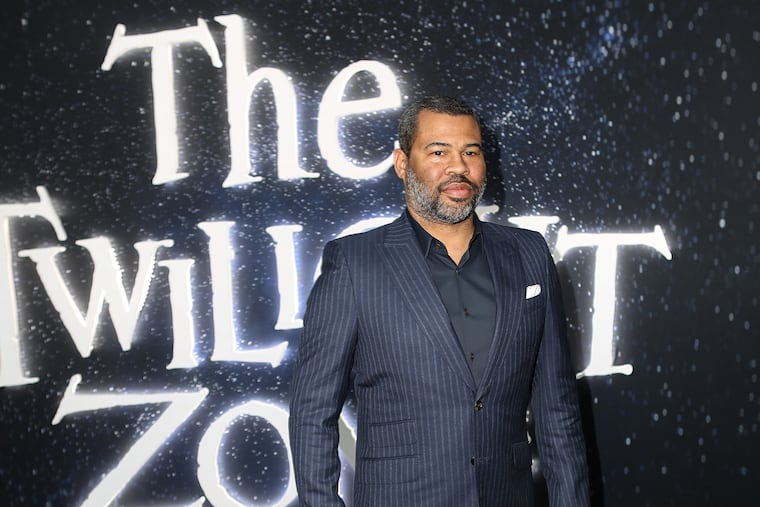Jordan Peele is the new master of suspense, and also a really good salesman
When 'Us' director Jordan Peele tells you can't really get his movie until you see it more than once, he shows he's mastered the techniques of the horror genre's best directors, and also its shrewdest salesman.

Jordan Peele has been on the stump for Us wearing the same outfit Jack Nicholson’s character wears in The Shining, and in case you missed the connection, he made it explicit on Twitter, posting the images side by side.
He also quoted the “all work and no play” line from the movie, cuing fans to the fact that there are Shining references in Us. All work and no play might also describe Peele’s approach to the tireless and shrewd promotion of his own films.
In that regard, he’s following in the tradition of the self-branding genre giants he admires — including Alfred Hitchcock and Rod Serling — guys he name-checks in Us with homages to Psycho and The Twilight Zone (in fact, he developed and narrates a new version of Serling’s classic that just premiered on CBS All Access). The references are among the hundreds of so-called Easter eggs he’s planted in the movie (“nothing is there by accident,” he teases) — pointed nods to other movies and influences to be discovered, detailed, and analyzed by fans.
All of which has led to the consensus that to be fully appreciated, Us must be seen at least twice. Repeat viewing, in fact, is now as much a part of the Peele brand as the catchy buzzwords he encodes in his scripts — the Sunken Place from Get Out, the Tethered from Us.
Peele is already an Oscar-winner for his Get Out screenplay but in a sense, his most impressive achievement is the way he leverages his acute understanding of geek fandom to build an audience of folks willing — nay, eager — to pay to see his movies multiple times.
That is salesmanship on a level so profound I couldn’t help thinking of William Castle, who must be kicking himself (in his grave, of course) for having not thought of it. Castle was the indie horror director/promoter who in the 1950s and ’60s made his bones by having a skeleton fly through the theater during The House on Haunted Hill and by issuing Lloyd’s of London life insurance polices to customers in case they died of fright during any screening of Macabre.
In Homicidal, he offered refunds to anyone too scared to continue watching — they could exit during a predetermined “fright break” and get their money back. He was chagrined to discover some fans gamed the gimmick by staying seated for consecutive screenings, then leaving during the second screening and collecting a refund — effectively seeing the movie free.
Convincing people they should pay to see a movie twice? Castle would have loved it. Certainly he would have admired Peele’s keen understanding of his audience, which for Peele comes from experience. He was himself an immersive, obsessive fan, and he understands firsthand how the interplay between movie and millennial moviegoer transcends the theater and extends to internet forums and social media, where fans decipher the cryptology/mythology of their favorite films.
The more Easter eggs you plant in a movie, the more fodder for discussion, the more tethered that fan base becomes to the movie and to the filmmaker.
Peele, who as an actor, comic, writer, director, producer, has done everything there is to do in Hollywood, knows the business as well as anyone. He knows that commercial power leads to creative flexibility. That’s the position he has engineered for himself with the $250 million that Get Out generated and the $180 million that Us has already racked up.
A word of caution, though, is in order. Fans who gorge strictly on Easter eggs can start to get the sense they are consuming empty calories. The repeat viewing that led to such a powerful audience hold on Get Out (it dipped less than 20 percent in its first week, and never more than 36 percent for most of its run), shows signs of eroding in Us, which lost half its audience in just a week.
And some fans find that with Us, repeat viewing is more mystifying than edifying. “I’ve seen the movie twice,” says one perplexed fan, “and I still have 53 unanswered questions.”
Indeed, many viewers (me included) think the movie has more clever references than internal logic. Characters are stalked by doppelgängers from a subterranean dimension, leading to a Big Reveal that raises as many issues as it resolves.
You can’t explore nagging questions without getting into spoilers, but you can find many quibbles online.
What’s with the clothes?
Do the tethered shop in the same place as Frances McDormand’s character in Three Billboards Outside Ebbing, Missouri?
Nothing but rabbits, really?
And who feeds the rabbits?
Diehard Peele fans decry this nit-picking kind of failure of imagination, the wonky protestations of the literal-minded. The movie isn’t intended to make logical sense, they say. It’s a horror movie, and it exists to be ineffably creepy.
Peele endorses this idea by saying the film is a “Rorschach test,” that the audience sees what it wants to see, but he’s been pretty clear that he wanted to make a movie about class and the connection between the privileged and underprivileged.
There is also a connection, he has suggested, between Get Out and Us, and it will be explored and revealed in future movies.
To investigate that nexus, of course, you’re going to have see those movies again.
And again. And again.
I see a boxed set in your future, with special commentary by the director. Maybe not in time for Easter, but certainly by Christmas.